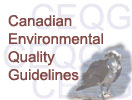

 
|
|
|
|
|
||

Home About Us What's New?/ What Are We Working On? Canadian Environmental Quality Guidelines Download Documents Bibliography CCME Links Contact Us Site Map |
Canadian Water Quality GuidelinesOverviewCanadian Water Quality Guidelines (CWQGs) have been subdivided into four categories:
Development of Canadian Water Quality Guidelines began in 1984. Canadian Water Quality Guidelines for the Protection of Aquatic LifeCanadian Water Quality Guidelines for the Protection of Aquatic Life help to protect all plants and animals that live in our lakes, rivers, and oceans by establishing acceptable levels for substances or conditions that affect water quality such as toxic chemicals, temperature and acidity. As long as conditions are within the levels established by the guidelines, one would not expect to see negative effects in the environment. The guidelines are based on toxicity data for the most sensitive species of plants and animals found in Canadian waters and act as science-based benchmarks for the protection of 100% of the aquatic life species in Canada, 100% of the time. Canadian Water Quality Guidelines for the Protection of Agricultural Water UsesCanadian Water Quality Guidelines for the Protection of Agricultural Water Uses help to protect sensitive crop species that may be exposed to toxic substances such as pesticides in irrigation water. They are based on maximum irrigation rates and the sensitivity of crops to pollutants. Similarly, the Canadian Water Quality Guidelines for Livestock Water are based on how livestock are affected by their drinking water and whether certain substances, such as toxic chemicals, accumulate in the animals' bodies. Guidelines for Canadian Drinking Water QualityCanadian Drinking Water Quality Guidelines help to protect the health of Canadians by establishing maximum acceptable concentrations for substances found in water used for drinking. To date, guidelines have been established for more than 85 physical, chemical, and biological attributes of water quality. The guidelines apply to all public and private drinking water supplies and to treated or finished water as it emerges from the tap. Drinking Water Quality Guidelines are developed by and available through Health Canada. Guidelines for Canadian Recreational Water QualityCanadian Recreational Water Quality Guidelines help to protect the health of Canadians using water for recreational activities like swimming and diving, white water sports, sailing, canoeing, and fishing. The guidelines deal mainly with potential health hazards such as infections transmitted by disease-causing micro-organisms, and aesthetics and nuisance conditions. Recreational Water Quality Guidelines are developed by and available through Health Canada. Procedures for Guideline Development (Protocol)The Canadian Water Quality Guidelines for the protection of aquatic life and agricultural uses are derived from the available literature on the effects of a substance or physical property (e.g., temperature) on various species. The technical review and summary of the substances include issues such as:
Science-based protocols for the development of Canadian Water Quality Guidelines have been approved by the CCME Water Quality Task Group - A Protocol for the Derivation of Water Quality Guidelines for the Protection of Aquatic Life (CCME 1999) and Protocols for Deriving Water Quality Guidelines for the Protection of Agricultural Uses (Irrigation and Livestock Water) (CCME 1999). Detailed technical reports supporting the CWQGs are reviewed by members of the CCME Water Quality Task Group and other scientific and technical experts. Final approval is the responsibility of CCME management. Application of GuidelinesThe Guidelines should not be regarded as blanket values for national water quality. Variations in environmental conditions across Canada will affect water quality in different ways and many of the guidelines may need to be modified according to local conditions such as assimilative capacity, sensitivity of endangered species and habitat. Site-specific water quality objectives (see A Protocol for the Derivation of Water Quality Guidelines for the Protection of Aquatic Life) are established to reflect the local environment and may be adopted by a jurisdiction into legislation to become standards. It is the policy of the CCME that degradation of the existing water quality to the guideline value should always be avoided. Similarly, modifications of guidelines to site-specific objectives should not be made on the basis of aquatic ecosystem characteristics that have arisen as a direct result of previous human activities. The use of Canadian Water Quality Guidelines for site-specific water quality objectives requires an understanding of the chemical, physical, and biological characteristics of the water body and an understanding of the behaviour of a substance once it is introduced into the aquatic environment. Factors affecting the application of the guidelines include:
Products AvailableProtocolsThe protocols of the Canadian Water Quality Guidelines are available in HTML and PDF format. You need Adobe® Acrobat® Reader to view and print the PDF files. If you do not already have Acrobat® Reader, you may download it at no charge.
Brochure |
|
The Green LaneTM, Environment Canada's World Wide Web site
|
||
|
Last updated: 2004-03-01
Last reviewed: 2004-03-01 |
||
|
|
||